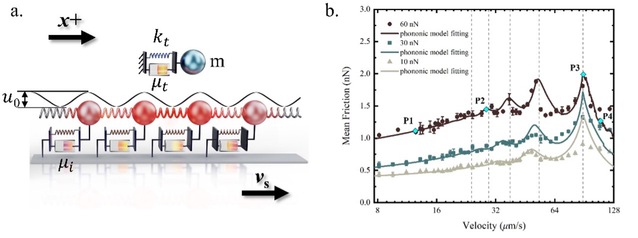Recently, Professor Chen Yunfei's research team from the School of Mechanical Engineering at Southeast University has made significant progress in the field of friction. Their research findings, titled 'Reexamination of Damping in Sliding Friction,' have been published in the prestigious physics journal 'Physical Review Letters' (Link: 10.1103/PhysRevLett.132.056203).

(a) Schematic diagram of the principle of atomic force microscopy testing of frictional force, where the research team proposed, for the first time internationally, a phonon friction model that correlates frictional resistance with slider vibration velocity; (b) The phonon friction model proposed by the research team accurately predicts the frictional force results obtained from atomic force microscopy testing.
The inception of friction signifies humanity's proactive utilization of thermal energy, marking the departure from the primitive ages of subsistence living. Friction arises from the relative motion between two objects, and therefore, frictional force is considered a dissipative force present at the frictional interface, converting mechanical energy into irreversible heat. Friction accounts for approximately one-third of the world's primary energy consumption. Research on friction dates back to the Renaissance period, where Leonardo da Vinci, Amontons, Coulomb, among others, proposed the famous laws of friction, stating that sliding frictional force is only dependent on the magnitude of the load and is independent of the contact area or the relative sliding velocity. This description of frictional force is not derived from first principles but rather an empirical summary of frictional phenomena. With the continuous improvement in measurement instruments' accuracy, an increasing number of research results indicate the inaccuracies of the laws of friction. For instance, at lower sliding velocities, frictional force increases with an increase in sliding velocity, while at higher sliding velocities, frictional force exhibits velocity weakening. To date, no theoretical model can predict frictional force accurately, and the magnitude of frictional force and the friction-induced vibration and noise remain uncertain.
Supported by continuous funding from the National Natural Science Foundation of China, the research team, after over twenty years of investigation, discovered that interfacial force during sliding friction is not a dissipative force. In the process of sliding friction, the interfacial interaction force merely converts mechanical energy into elastic potential energy of the elastic body, constituting a mechanical energy conservation process. This potential energy accumulates continuously until it surpasses a specific threshold, upon which it releases some accumulated potential energy in the form of phonons. Energy dissipation occurs across the entire elastic body, not just limited to the frictional interface, and the energy dissipation of the entire elastic body can be described using equivalent material damping. Thus, the damping of sliding friction is proportional to the vibration velocity of the elastic body, contrary to the assumption in traditional models that it is proportional to the relative velocity between the two sliding interfaces. Based on this foundation, the phonon friction model proposed can predict the frictional force measured by frictional force microscopy and has been validated by molecular dynamics simulation models. Furthermore, the phonon friction model can explain long-standing perplexing phenomena in frictional studies, such as the velocity weakening phenomenon observed during earthquakes and the dependency of frictional force on spring stiffness in engineering practices.
The work of the research team challenges the traditional notion that frictional force is a dissipative force at the interface, and the proposed phonon friction model not only deepens our understanding of the mechanisms behind frictional energy dissipation but also holds significant implications for actively controlling friction, mechanical vibration noise, and heat transfer. Active control of friction and phonon transport is the primary research direction of Professor Chen Yunfei. Exploring the energy dissipation mechanism during friction processes and actively controlling mechanical vibration noise and heat transfer by intervening in the energy dissipation process. Previous related achievements have also been published in international journals such as Physical Review B 108,214313(2023), Nature, 615 (7950), E1-E2 (2023), Science, 382 (6676), 1265-1269 (2023), ACS Applied Materials & Interfaces 15, 45516-45525 (2023), Friction 11, 966-976(2023), Nano Letters 21, 4615-4621 (2021), Journal of Applied Physics 127, 015105 (2020), Nano Letters 15, 4704-4712 (2015), etc. Dr. Huang Shuyu, Associate Professor Wei Zhiyong, Postdoctoral Fellow Duan Zaoqi, and Doctoral Candidate Sun Chengdong serve as the first authors of the paper, while Professor Chen Yunfei from Southeast University and Professor Deyu Li from Vanderbilt University in the United States serve as corresponding authors. This research was supported by the National Natural Science Foundation of China (Grant Nos. 52035003, 52127811, 52175161, 51705074, 51575104, and 59805003), the National Key Research and Development Program, the Jiangsu Provincial Postdoctoral Fund, and the Tang Zhongying Foundation, among others.

